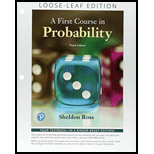
The following algorithm will generate a random permutation of the elements 1,2, ..., n. It is somewhat faster than the one presented in Example 1a, but is such that no position is fixed until the algorithm ends. In this algorithm,
Step 1. Set
Step 2. Set
Step 3. If
Step 4. Generate a random number U and let
Go to step 3.
a. Explain in words what the algorithm is doing.
b. Show that at iteration k—that is. when the value of P(k) Is initially set—
P(1), P(2), ..., P(k) is a random permutation of 1, 2, ..., k.
Hint: Use induction and argue that
(a)
To find: the explanation that the algorithm is doing.
Explanation of Solution
Given:
Some steps of algorithm are given.
The algorithm starts by initially putting k=1 thus it sets
Then, until
This algorithm start by putting
Therefore, therequired explanation is shown above.
(b)
To prove:that the set
Explanation of Solution
Given:
It is given that
As it is given that the condition
It is known that;
Then, the given condition becomes;
Similarly,
This proves that at iteration k can be defined as
Therefore, the required identity has been proved.
Want to see more full solutions like this?
Chapter 10 Solutions
FIRST COURSE IN PROBABILITY (LOOSELEAF)
Additional Math Textbook Solutions
Elementary Statistics: Picturing the World (7th Edition)
Pathways To Math Literacy (looseleaf)
A Problem Solving Approach To Mathematics For Elementary School Teachers (13th Edition)
Thinking Mathematically (6th Edition)
Elementary and Intermediate Algebra: Concepts and Applications (7th Edition)
Elementary & Intermediate Algebra
- Total marks 16 5. Let (N,F,P) be a probability space and let X : N → R be a random variable such that the probability density function is given by f(x)=ex for x € R. (i) Find the characteristic function of the random variable X. [8 Marks] (ii) Using the result of (i), calculate the first two moments of the random variable X, i.e., E(X") for n = 1,2. (iii) What is the variance of X. [6 Marks] [2 Marks]arrow_forward6. Let P be the standard normal distribution, i.e., P is the proba- bility measure on (R, B(R)) given by 1 dP(x) = 를 = e dx. √2πT Consider the random variables 21 fn(x) = (1 + x²) en+2, x Є R, n Є N. Using the dominated convergence theorem, prove that the limit Total marks 9 exists and find it. lim E(fn) n∞ [9 Marks]arrow_forward6. Let X be a random variable taking values in (0,∞) with proba- bility density function fx(u) = 5e5u u > 0. Total marks 8 Let Y = X2. Find the probability density function of Y. [8 Marks]arrow_forward
- 5. Let a probability measure P on ([0,3], B([0,3])) be given by 1 dP(s): = ½ s² ds. 9 Consider a random variable X : [0,3] → R given by X(s) = s², sc [0,3]. S Total marks 7 Find the distribution of X. [7 Marks]arrow_forwardProblem: The probability density function of a random variable is given by the exponential distribution Find the probability that f(x) = {0.55e−0.55x 0 < x, O elsewhere} a. the time to observe a particle is more than 200 microseconds. b. the time to observe a particle is less than 10 microseconds.arrow_forwardProblem: The probability density function of a random variable is given by the exponential distribution Find the probability that f(x) = {0.55e-0.55 x 0 < x, O elsewhere} a. the time to observe a particle is more than 200 microseconds. b. the time to observe a particle is less than 10 microseconds.arrow_forward
- Unknown to a medical researcher, 7 out of 24 patients have a heart problem that will result in death if they receive the test drug. 5 patients are randomly selected to receive the drug and the rest receive a placebo. What is the probability that less than 4 patients will die? Express as a fraction or a decimal number rounded to four decimal places.arrow_forwardWas wanting to check if my calculations were correct Suppose 52% of the population has a college degree. If a random sample of size 808 is selected, what is the probability that the proportion of persons with a college degree will be less than 54%? Round to four decimal places. after following the formula I got 0.8724arrow_forwardAt the beginning of each semester, students at the University of Minnesota receive one prepaid copy card that allows them to print from the copiers and printers on campus. The amount of money remaining on the card can be modeled by a linear equation where A represents how much remains on the card (in dollars) and p represents the number of pages that the student has printed. The graph of this linear equation is given below. 100 90 80 70 60 50 40 30 20 10 0 A = Amount on Card ($) 0 200 400 600 800 1000 1200 1400 1600 p = Number of Pages Printed What information does the vertical intercept tell you (represent) for this problem? Be sure to include specific details in your answer -- your answer should have both quantitative and qualitative data to describe the answer in terms of the question.arrow_forward
- Data management no 2 thanksarrow_forwardG12 Data Management please help on the first question no 1 belowarrow_forwardTotal marks 14 4. Let X and Y be random variables on a probability space (N, F, P) that take values in [0, ∞). Assume that the joint density function of X and Y on [0, ∞) × [0, ∞) is given by f(x, y) = 2e-2x-y Find the probability P(0 ≤ X ≤ 1,0 ≤ y ≤ 2). (ii) spectively. [6 Marks] Find the the probability density function of X and Y, re- [5 Marks] 111) Are the X and Y independent? Justify your answer! [3 Marks]arrow_forward
 Linear Algebra: A Modern IntroductionAlgebraISBN:9781285463247Author:David PoolePublisher:Cengage LearningAlgebra & Trigonometry with Analytic GeometryAlgebraISBN:9781133382119Author:SwokowskiPublisher:Cengage
Linear Algebra: A Modern IntroductionAlgebraISBN:9781285463247Author:David PoolePublisher:Cengage LearningAlgebra & Trigonometry with Analytic GeometryAlgebraISBN:9781133382119Author:SwokowskiPublisher:Cengage Elements Of Modern AlgebraAlgebraISBN:9781285463230Author:Gilbert, Linda, JimmiePublisher:Cengage Learning,
Elements Of Modern AlgebraAlgebraISBN:9781285463230Author:Gilbert, Linda, JimmiePublisher:Cengage Learning,


